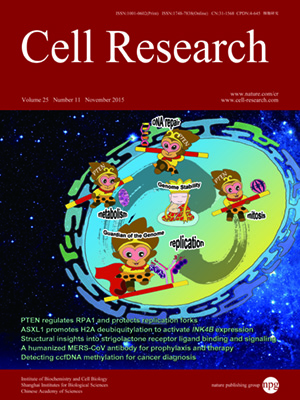
Volume 25, No 11, Nov 2015
ISSN: 1001-0602
EISSN: 1748-7838 2018
impact factor 17.848*
(Clarivate Analytics, 2019)
Volume 25 Issue 11, November 2015: 1237-1249
ORIGINAL ARTICLES
A humanized neutralizing antibody against MERS-CoV targeting the receptor-binding domain of the spike protein
Yan Li1,*, Yuhua Wan1,2,3,*, Peipei Liu1,*, Jincun Zhao4,11, Guangwen Lu5, Jianxun Qi1, Qihui Wang3, Xuancheng Lu6, Ying Wu1, Wenjun Liu1, Buchang Zhang2, Kwok-Yung Yuen7, Stanley Perlman4, George F Gao1,2,8,9,10 and Jinghua Yan1,2,3
1CAS Key Laboratory of Pathogenic Microbiology and Immunology, Institute of Microbiology, Collaborative Innovation Center for Diagnosis and Treatment of Infectious Diseases, Chinese Academy of Sciences, Beijing 100101, China
2School of Life Sciences, Anhui University, Hefei, Anhui 230039, China
3CAS Key Laboratory of Microbial and Metabolic engineering, Institute of Microbiology, Chinese Academy of Sciences, Beijing 100101, China
4Departments of Microbiology and Pediatrics, University of Iowa, Iowa City, IA 52242, USA
5State Key Laboratory of Biotherapy and Cancer Center, West China Hospital, West China Medical School, Sichuan University, Chengdu, Sichuan 610041, China
6Laboratory Animal Center, Chinese Center for Disease Control and Prevention (China CDC), Beijing 102206, China
7State Key Laboratory for Emerging Infectious Diseases, Department of Microbiology, The University of Hong Kong, Pokfulam, Hong Kong SAR 60518120, China
8National Institute for Viral Disease Control and Prevention, Chinese Center for Disease Control and Prevention (China CDC), Beijing 102206, China
9China-Japan Joint Laboratory of Molecular Microbiology and Molecular Immunology, Institute of Microbiology, Chinese Academy of Sciences, Beijing 100101, China
10Office of Director-General, Chinese Center for Disease Control and Prevention (China CDC), Beijing 102206, China
11State Key Laboratory of Respiratory Diseases, Guangzhou Institute of Respiratory Disease, The First Affiliated Hospital of Guangzhou Medical University, Guangzhou, Guangdong 510120, China
Correspondence: Jinghua Yan, E-mail: yanjh@im.ac.cn; George F Gao,(gaof@im.ac.cn)
The newly-emerging Middle East respiratory syndrome coronavirus (MERS-CoV) can cause severe and fatal acute respiratory disease in humans. Despite global efforts, the potential for an associated pandemic in the future cannot be excluded. The development of effective counter-measures is urgent. MERS-CoV-specific anti-viral drugs or vaccines are not yet available. Using the spike receptor-binding domain of MERS-CoV (MERS-RBD) to immunize mice, we identified two neutralizing monoclonal antibodies (mAbs) 4C2 and 2E6. Both mAbs potently bind to MERS-RBD and block virus entry in vitro with high efficacy. We further investigated their mechanisms of neutralization by crystallizing the complex between the Fab fragments and the RBD, and solved the structure of the 4C2 Fab/MERS-RBD complex. The structure showed that 4C2 recognizes an epitope that partially overlaps the receptor-binding footprint in MERS-RBD, thereby interfering with the virus/receptor interactions by both steric hindrance and interface-residue competition. 2E6 also blocks receptor binding, and competes with 4C2 for binding to MERS-RBD. Based on the structure, we further humanized 4C2 by preserving only the paratope residues and substituting the remaining amino acids with the counterparts from human immunoglobulins. The humanized 4C2 (4C2h) antibody sustained similar neutralizing activity and biochemical characteristics to the parental mouse antibody. Finally, we showed that 4C2h can significantly abate the virus titers in lungs of Ad5-hCD26-transduced mice infected with MERS-CoV, therefore representing a promising agent for prophylaxis and therapy in clinical settings.
10.1038/cr.2015.113
FULL TEXT | PDF
Browse 2482


